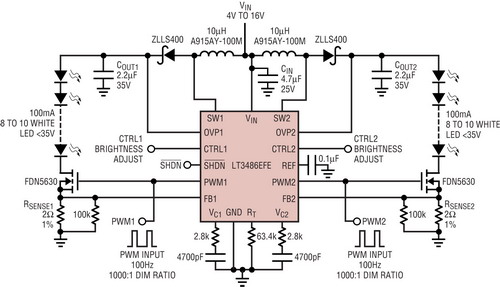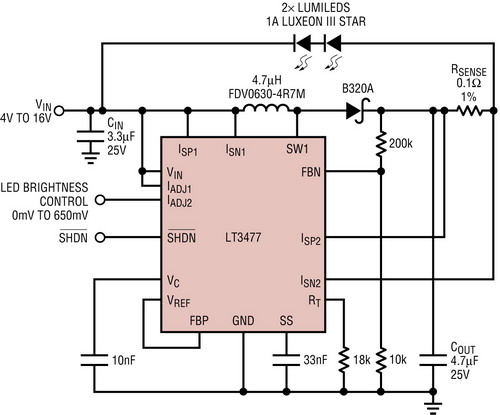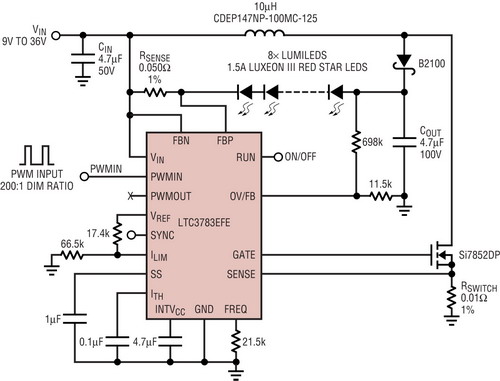introduction
This article refers to the address: http://
Compared to current automotive interior and exterior lighting solutions, LED lighting has many advantages, such as higher performance, longer life, lower cost, etc. This lighting method enhances the aesthetics and performance of automotive lighting. Driving a LED directly from a car battery requires a DC/DC converter to regulate a constant LED current and protect the LED from the unpredictable car battery bus. Such converters should also be optimized for the number of LEDs contained in a string of LEDs and the type of LED, and also for applications such as headlights, taillights and signal indicators, internal reading lights, instrument panels or entertainment display lighting. Optimization, the areas that need to be optimized are as follows:
Topology—The relationship between LED voltage and battery voltage determines the buck, boost, or buck-boost topology. The topology chosen should maintain control of the LED current over the entire battery voltage range.
Dimming - A large proportion of LED dimming must maintain the same color characteristics at the brightness level and there is no undulation or oscillation visible to the eye.
Efficiency - Power consumption in non-operating state consumes battery power, and in an environment where the heat pressure of the car is already large, the amount of electricity consumed is converted into heat.
Drive a single LED
White and white ceiling lights and makeup lamps may use one or two 3W LEDs, each producing 75 to 100 lumens of brightness. These LEDs typically have a forward voltage range of 3V to 4.5V and a maximum current of 1A to 1.5A, such as the Luxeon IIIStar from Lumileds (). The simplest LED driver design uses a buck regulator to drive a single LED directly from a car battery. Figure 1 shows a single LED internal lighting circuit with dimming capability. Typical operating voltages for automotive batteries range from 9V to 16V (typically 12V). A battery that consumes power may drop to 9V before the car starts, and the alternator charges it after the car starts, returning its voltage to as high as 14.4V. When the cold car is started, the battery voltage may drop to 4V, and only critical electronic circuits must work.

Figure 1: Step-down high-voltage 1ALED driver LT3474 with 250:1 PWM dimming ratio
The long cable between the battery and the chassis and the electronic noise environment always cause high voltage spikes in the car. 36V transients must be considered when choosing a switching regulator for automotive design. Higher voltage spikes are often handled with simple protection diodes or filters.
The LT3471 converter IC used in Figure 1 is a high voltage, high current step-down LED converter with a wide PWM dimming ratio that can drive one or more LED currents up to 1A. The LT3471's features make it ideal for driving LEDs in automotive environments:
* It is a dedicated LED driver with on-chip high voltage switch and low voltage current monitoring resistor to minimize board area and simplify design while maintaining high efficiency.
The wide input voltage range of 4V to 36V allows the LED driver to operate directly from the automotive battery while providing constant LED current.
* Its buck topology and adjustable wide frequency range allow the use of small, low cost, high temperature coefficient ceramic capacitors to provide low ripple LED current.
The efficiency of the LT3474 single LED buck converter is higher than 80% at 12VIN. When analog control is performed through the VADJ pin, the efficiency decreases as the LED current and brightness decrease, but the power consumption remains low. Tailored for automotive and battery-powered applications, the LT3474 consumes less than 2uA (typically 10nA) when placed in a shutdown state. The shutdown can also function as an LED on/off button, just like a button or microcontroller. The LT3475LED driver is a dual version of the LT3474 that can drive two separate LEDs or LED strings with a current of 1.5A.
PWM dimming and brightness control
The LED brightness can be controlled by the LT3474 in Figure 1, connecting an analog voltage input to the VADJ pin or a digital PWM signal to the gate and PWM pins of the PWM dimming MOSFET. Simple analog brightness control reduces the constant LED current from 1A to a lower value by lowering the voltage across the internal sense resistor, but the color of the LED light changes at low currents. The practical limit of the dimming ratio is approximately 10:1.
Another way to reduce the brightness is digital PWM dimming. During PWM turn-on, the LED current is very well stabilized at 1A. During PWM turn-off, the LED current is zero. This maintains the color and true color characteristics of the LED light while reducing the brightness.
The PWM function responds very quickly to PWM dimming when the LED is returned to the programmed current value inside the integrated circuit. The LT3474's maximum digital PWM dimming ratio is 250:1, which is rich for internal lighting. The LT3475 can be dimmed at a dimming ratio higher than 1000:1.
LCD display with LED string illumination
GPS navigation and in-car entertainment displays require bright LED strings in daylight conditions and wide dimming ratios when working at night. LED strings cause a different problem than a single LED dome. In these displays, for smaller LEDs, multiple LED string currents consisting of 6 to 10 LEDs are typically low (<150 mA), but the accumulated voltage is higher than the car battery voltage. For these displays, high power boost topology LED drivers with high efficiency and PWM dimming capability are required.
Figure 2 shows the application of the LT3486 dual-output boost LED driver, which drives two strings of LEDs at a constant current of 100mA with an LED voltage of up to 36V.
This boost converter uses a small voltage sense resistor in series with the LED string and PWM dimming MOSFET and has high efficiency. The entire battery voltage range of 9V to 16V is lower than the voltage of the LED string. The dual-channel LED driver drives two LED strings of 20 LEDs while maintaining the highest switching voltage below the 42V rating of the IC. A single LED string consisting of 20 LEDs requires a much higher voltage.

Figure 2: In a GPSLCD display, the LT3486 drives 20 white LEDs at 100mA
The efficiency is approximately 90% over the battery operating voltage range. If the battery voltage drops to 4V, the LT3486 will still work, but depending on the LED programming current and the number of LEDs, it may enter the current limit state. The converter consumes less than 1uA (typically 100nA) of current when it is shut down. The LED current is set by selecting an external sense resistor value, and the sense resistor is selected based on a very low 200mV sense resistor voltage to achieve high efficiency. The current of each LED string can be adjusted with an analog signal on the CTRL pin, with a maximum dimming ratio of 10:1, or with a PWM signal to achieve a much higher dimming ratio.
For nighttime viewing of extremely bright displays, the LT3486 offers a 1000:1 PWM dimming ratio with its unique internal PWM dimming architecture. The internal LED current memory has an ultra-fast PWM response time that allows the LED current to return from zero to 100mA for less than 10us for true color PWM dimming. In the high-end display, two LT3486s are used to drive four LED strings of red, green, green, and blue (RGGB), which can achieve a 1000:1 dimming ratio and maintain the true color of the display in a very dark nighttime working environment. characteristic.
Signal indicator, taillight and headlight illumination
External signal indicators, taillights, and headlights require the highest power DC/DC LED drivers because they use the brightest LEDs and the largest number of LEDs. Although extremely bright LED headlamps are not common due to thermal and steady flow limitations, red and yellow-brown brake lights and signal indicators are becoming more common due to their aesthetics and durability. Driving high-powered tan and red LED strings presents similar challenges for interior lighting and fine-tuning of lighting, but the challenges are different. A high dimming ratio is not required, but simple on/off and high/low brightness functions are useful. The voltage of the LED string often exceeds the voltage range of the car battery, requiring an LED driver with buck and boost, or buck-boost capability.
The LT3477 buck-boost LED driver shown in Figure 3 drives two high-power LEDs at 1A. These two LEDs do not need to be ground referenced, and the two terminals connected are typically the converter's output and battery input. The LT3477 has two unique and 100mV floating current sense input pins that are connected in series with the LED string and are not ground referenced. In the operating voltage range of the car battery and below this range, accurate LED steady current can be achieved with current up to 1A. The LT3477's shutdown pin is used to turn the light on/off function and reduce the input current to 1uA (typically 100nA) when not in use. The IADJ pin is used to achieve an analog dimming ratio of more than 10:1 for brake and taillight applications such as rear signal indicators or brake lights. This type of application does not require true color PWM dimming.

Figure 3: Buck-boost LT3477 drives 1A brake light and signal indicator LED string with 80% efficiency
As shown in Figure 4, the high-power LED driver LTC3783 uses a buck-boost topology to drive 6 to 10 3W red LEDs for automotive taillight applications. External switching MOSFETs and switch current sense resistors provide maximum design flexibility for high power and high voltage LED driver designs. If the battery voltage drops below 9V, then a 9V to 36V input and up to 25V LED string output at 1.5A requires a nominal switching voltage of 100V and a peak switching current capability of greater than 8A. The 1.5A constant battery current is well stabilized over the entire automotive battery voltage range. For brake and taillight dimming, at 100Hz, the LED current can be reduced with a PWM signal directly connected to the LTC3783PWM pin to achieve a dimming ratio of up to 200:1. At 1 kHz, the dimming ratio is reduced to ?20:1, which is sufficient for taillight applications. Adjusting the ILIM pin also reduces the LED current.

Figure 4: LTC3783 Brake Light LED Driver Drives Eight 1.5A Red LEDs with Over 90% Efficiency
In the most powerful automotive applications, high efficiency is paramount. In this application, with an output of up to 36W, 93% efficiency can reduce battery consumption during braking, especially when the car is not running. The RUN pin for brake light on/off control reduces the LED current to 20uA.
By connecting the LED string to GND instead of VIN and changing the topology to boost, the LTC3783 high-power LED driver's flexibility can be turned into a high-power step-up regulator to drive higher voltage LED strings up to 60W. This requires a maximum battery voltage of more than 36V for the LED string voltage, and LED disconnection via the PWM pin is required when the lamp is turned off. High-power LED drivers with boosted topologies will soon be used in high lumen headlamp applications using very bright white LEDs.
in conclusion
Many automotive LED applications require dedicated high power, yet simple and efficient LED drivers. There are different combinations of LEDs depending on the application, but various combinations require low current consumption, high PWM and analog dimming ratios, and excellent LED current regulation when disconnected. Linear Technology offers a wide range of automotive LED drivers to overcome all of these challenges.
Trolley Plastic Speaker:
Our hot selling products: Trolley Plastic Speaker. You can also call it outdoor dancing speaker, Portable Karaoke Speaker. Trolley Plastic speaker has plastic enclosure, stylish, small, portable and compact. It built in trolley handle and wheels Wireless outdoor stereo speaker with TF/USB/MP3. You can use it enjoy webcast, movie, music, and also you can use it to accompany when you dance. Especially it is a mini Karaoke systems, you can sing everywhere if you like, it can bring you unexpected happiness. We are looking forward to establish win-win business relationships with you. Warm welcome you to our company and introduction this trolley speaker systems to you!


Trolley Plastic Speaker
Trolley Plastic Speaker,Trolley Speaker Systems,Trolley Speaker With Wifi,Trolley Speaker With Led Screen
Shenzhen New Wonderful Technology Co., Ltd. , https://www.sznewwonderful.com